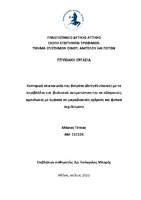| dc.contributor.advisor | Μπερής, Ευάγγελος | |
| dc.contributor.author | Τότκας, Μάριος | |
| dc.date.accessioned | 2022-10-24T07:50:42Z | |
| dc.date.available | 2022-10-24T07:50:42Z | |
| dc.date.issued | 2022-10-21 | |
| dc.identifier.uri | https://polynoe.lib.uniwa.gr/xmlui/handle/11400/3208 | |
| dc.identifier.uri | http://dx.doi.org/10.26265/polynoe-3048 | |
| dc.description.abstract | Η παρούσα πτυχιακή εργασία πραγματεύεται την επικοινωνία σε κυτταρικό επίπεδο, του μύκητα του βοτρύτη (Botrytis cinerea) με το περιβάλλον κατά την εκβλάστηση και ανάπτυξη του στο αμπέλι και την βιολογική αντιμετώπιση βασιζόμενη σε παράγωγα μικροοργανισμών ή φυτικών εκχυλισμάτων. Γίνεται αναφορά στις βασικές λειτουργίες και οργανίδια του φυτικού κυττάρου, στις διαδικασίες άμυνας του κατά την προσβολή από παθογόνα για την επιβίωση του φυτού, αλλά και από τη μεριά των παθογόνων στις μεθόδους παράκαμψης της άμυνας των φυτών. Αναφέρονται οι κυριότερες ασθένειες και εχθροί που προσβάλουν τους αμπελώνες με έμφαση στον ασκομύκητα Botrytis cinerea. Γίνεται περιγραφή στο πως συμπεριφέρεται ο μύκητας ανάλογα με τις περιβαλλοντικές συνθήκες και τα οργανίδια που χρησιμοποιεί για την ανάπτυξη του. Αναλύεται η απόκριση του μύκητα στα διαφορετικά ερεθίσματα του περιβάλλοντός του και τα σηματοδοτικά μονοπάτια που ενεργοποιούνται στο εσωτερικό του κυττάρου, ώστε να πετύχει να επιτελέσει τις κυτταρικές λειτουργίες για την βλάστηση και ανάπτυξη του. Επιπρόσθετα, παρατίθενται οι μέθοδοι αναπαραγωγής του Botrytis cinerea και το πώς εμφανίζονται τα συμπτώματα του μύκητα στην καλλιέργεια, καθώς και οι ζημιές που προκαλεί. Ακολούθως, στην τελευταία ενότητα της εργασίας, περιγράφονται οι τρόποι αντιμετώπισης του μύκητα τόσο από τη μεριά του φυτού όσο και από μηχανική παρέμβαση του ανθρώπου στην καλλιέργεια, με έμφαση στη βιολογική αντιμετώπιση του από παραγόμενα φυτοφάρμακα σχετιζόμενα με την αντίσταση έναντι του μύκητα, που βασίζονται σε οργανικές ενώσεις προερχόμενες από φυτικά εκχυλίσματα ή οργανισμούς ή ακόμα και από καθαυτού μικροοργανισμούς που αναπτύσσονται ανταγωνιστικά έναντι του Botrytis cinerea. | el |
| dc.format.extent | 66 | el |
| dc.language.iso | el | el |
| dc.publisher | Πανεπιστήμιο Δυτικής Αττικής | el |
| dc.rights | Αναφορά Δημιουργού - Μη Εμπορική Χρήση - Παρόμοια Διανομή 4.0 Διεθνές | * |
| dc.rights | Attribution-NonCommercial-NoDerivatives 4.0 Διεθνές | * |
| dc.rights.uri | http://creativecommons.org/licenses/by-nc-nd/4.0/ | * |
| dc.subject | Βοτρύτης | el |
| dc.subject | Botrytis cinerea | el |
| dc.subject | Βοτρύτιδα | el |
| dc.subject | Κυτταρική επικοινωνία Βοτρύτη | el |
| dc.subject | Κυτταρική επικοινωνία Botrytis cinera | el |
| dc.title | Κυτταρική επικοινωνία του Βοτρύτη (Botrytis cinerea) με το περιβάλλον και βιολογική αντιμετώπιση του σε ελληνικούς αμπελώνες με έμφαση σε μικροβιακούς εχθρούς και φυτικά εκχυλίσματα | el |
| dc.title.alternative | Cellular communication of Botrytis (Botrytis cinerea) with the environment and its biological control in Greek vineyards with emphasis on microbial control agents and plant extracts | el |
| dc.type | Πτυχιακή εργασία | el |
| dc.contributor.committee | Ευαγγέλου, Αλεξάνδρα | |
| dc.contributor.committee | Κεχαγιά, Δέσποινα | |
| dc.contributor.faculty | Σχολή Επιστημών Τροφίμων | el |
| dc.contributor.department | Τμήμα Επιστημών Οίνου, Αμπέλου και Ποτών | el |
| dc.description.abstracttranslated | The present thesis focuses on the communication at cellular level of the fungus Botrytis cinerea with the environment during its germination and growth οn the vine and its biological control based on derivatives of microorganisms or plant extracts. The basic functions and organelles of the plant cell, its defence processes against pathogen attack for the survival of the plant and from the pathogen's point of view, methods of bypassing the plant's defence against pathogens, are discussed. The diseases and pests affecting vineyards are mentioned, with emphasis on the ascomycete Botrytis cinerea. A description is given of how the fungus is modulated according to environmental conditions and the organelles it uses for its growth. The response of the fungus to the different stimuli of its environment and the signalling pathways that are activated inside the cell in order for it to succeed in carrying out the cellular functions for germination and growth are analysed. Moreover, reproduction of Botrytis cinerea as well symptomatology and damages caused by the fungus, are listed. Subsequently, in the last section of the paper, the ways to control the fungus both from the plant's side and by mechanical human intervention in the crop are described. Emphasis is given on the biological control by produced pesticides related to resistance against the fungus that are based on organic compounds derived from plant extracts or organisms, or even from whole microorganisms that grow competitively against Botrytis cinerea. | el |


